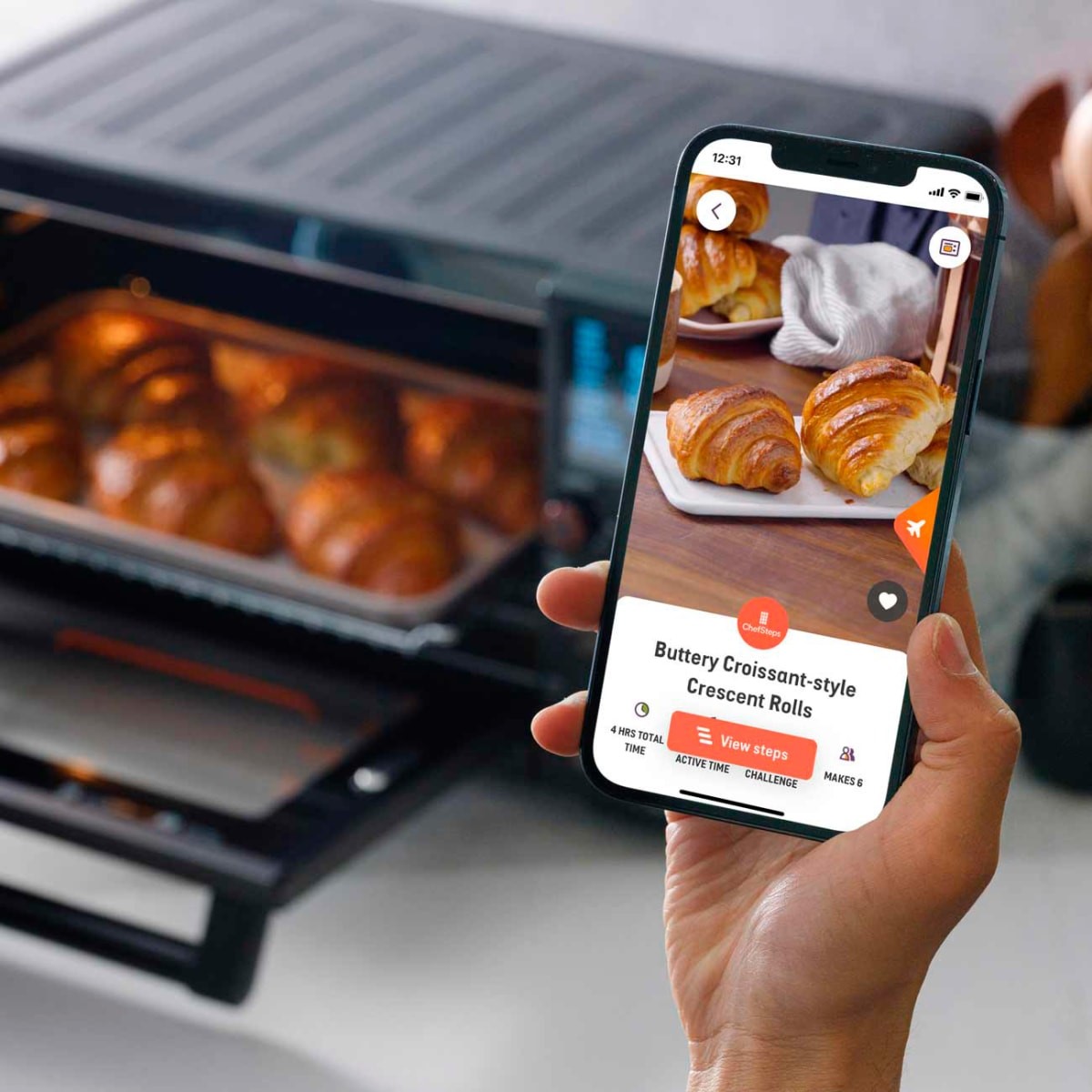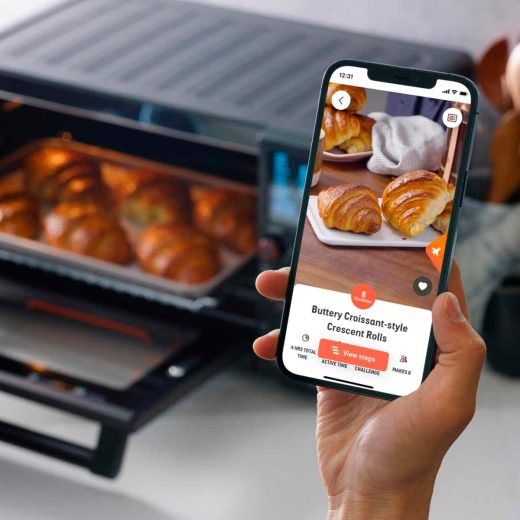Breville’s big digital strategy isn’t making smarter devices—it’s making smarter cooks
We live in the era of Peak Recipe, a time when any enthusiastic culinarian may be juggling as many cooking subscriptions as they do streaming services. Even still, actually breaking out of your dinner rut is a perpetual challenge, and that goes double if you aren’t confident in the kitchen.
That’s why Breville is trying to erase the boundary between the recipe and the cooking appliance. When no one was looking last month, the company relaunched its app, Breville+, as a beautiful, free-to-use recipe collection for anyone who owns Breville appliances.
Not only is it full of step-by-step videos, depicting recipes that Breville has licensed from America’s Test Kitchen, Serious Eats, and NYT Cooking, but each recipe has also been carefully tested and translated for your particular Breville machine’s make and model. The recipes teach you to cook through demonstration, while promising to come out perfectly every time on Breville’s unique hardware.
Breville makes some of the most beloved appliances in the modern kitchen, and, in 2022, the company reached a record $1.4 billion in revenue thanks to its sweet spot in the market: In a world where it’s increasingly hard to buy a decent product of any sort, Breville promises relatively affordable, durable, simply designed appliances, from pizza ovens to espresso makers to water boilers to the top-rated countertop oven on the market.
But now, Breville is making a significant push into its digital side of the business—an area that was more or less nonexistent for Breville before the company began making significant investments in 2019. While many companies have focused on IoT integration into so-called smart appliances that promise to replace the need for cooking talent, Breville’s burgeoning digital strategy is more about making the average home cook smarter instead—and connecting them closer with the recipes from publications Breville knows their customer admires.
“What we’re trying to do with our experiences is not to take away the cooking but to empower the experiences to feel more joyful,” says Grant Crilly, Executive Producer at Breville. “I feel like we’ve succeeded when we make cooking as rewarding as eating itself.”
The Breville+ experience
Breville+ welcomes you by asking you to scan the barcode on the back of your appliance (ovens and sous vide are the only currently supported categories for now). After it verifies your product, you unlock access to their full recipe database.
While you can explore topics like beef or baking, and technically search for simple recipes like cooking bacon, you’ll likely be sucked into the rich imagery and video across the app. Tap on a recipe for, say, creme brûlée, and you’re whisked away to see the recipe prepped—which is a full-blown multimedia experience.
A torch burns the crust on the custard. A spoon breaks through its icy gossamer of carmelized sugar. And in goes a big spoon. Your appetite, fully whetted, can now give way to your logical side. Scroll down the page and you’ll get a list of ingredients and step-by-step instructions. These instructions are particularly supportive. You can simply read them, or tap in to any step to get a video demonstrating how you do something like choose the right-sized jar or whisk an egg yoke on the stove without making scrambled eggs.
“[We] only use words for things words are good at,” says Crilly. “Then use the visuals for the how [on steps] that can be exhaustive to explain semantically.”
Breville acquired Crilly’s old company, ChefSteps, in 2019, and it’s easy to track its information design lineage in these step-by-step recipe presentations in Breville+. You may remember ChefSteps as the cooking content and hardware company that spun out of the contemporary cooking bible Modernist Cuisine, which Crilly played a major role in developing, too.
Tailoring content to the machine
Now, that same rigor is being applied inside Breville to translate recipes to the Breville+ app. That translation includes hours of test cooking, and sometimes making small adjustments to the recipes in bake time and temperature depending on the Breville oven at work. Even small details like how many cookies can fit on a tray, or how many trays you should bake at once, or where the rack position(s) should be set are all parts of this recipe tailoring. And in the chance that Breville is actually changing something more significant about ingredients or prep, they get approval from their publishing partners, first.
Breville’s main test kitchen is in Sydney (and helmed by Otto Römer who is formerly of the Fat Duck Group), but its U.S. test kitchen is in Seattle where ChefSteps originated—and right across the street lives the entire Breville digital UX team. The result is not just a beautiful, poised presentation in the app, but one that’s fully related to product strategy. “We don’t see any delineation between hardware and software, because consumers don’t as much anymore,” says Andrew Sirontik, Breville’s chief solutions officer. Rather, Breville views their customers just like a phone or app developer would, as their “install base” that needs long term support to earn long term loyalty.
That said, one strategic question I asked the team was: Why make someone buy a Breville appliance to access these recipes at all? Because the free access is quite appealing. If you were to get subscriptions to these publications yourself, it would cost well over $100 a year. Isn’t the app already one giant (though useful) Breville ad, demonstrating recipes made on their equipment? Don’t they want to reach the largest audience possible?
“That is the question. We have this debate on a weekly basis internally,” says Sirontik, who openly admits that free access wouldn’t support their ultimate business model that comes back to purchasing appliances. “[We want] to create a brand aura that buying a Breville is a backstage pass to a whole world of cooking.”
The fuzzy future of cooking
For now, Breville+ is mostly a pretty, customized recipe app. But Breville customers who own Breville’s Wi-Fi-connected Joule oven do get a bit more functionality: The app will automatically turn the oven on with the right settings to match the recipe they’re cooking.

Moving forward, Breville is remaining tight-lipped as to how much control and automation they are planning to build into the app, but they expect to add more Breville products to the recipe database in the future and imagine how recipes might actually chain together multiple Breville products (like how you might cook a steak sous vide before searing the crust in a pan or under a broiler). These are both ideas that could be great or could grow unwieldy, depending on their exact execution. In any case, while high tech cookery has forgotten this lesson in the past, Breville recognizes that the home cook is the most important ingredient in their business model, and so it’s more important to support their experience cooking rather than erasing it.
“If it’s just automated, now we’re in a world as a business where we’re just competing with convenience, which puts us in competition with Uber Eats,” says Crilly. “Which is not a game I want to be in.”
(30)


